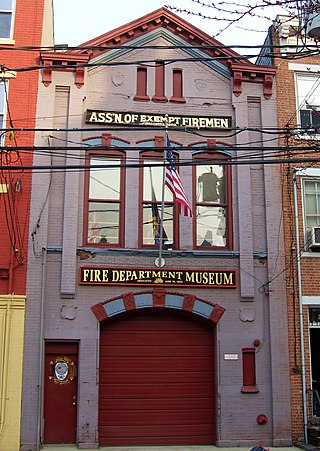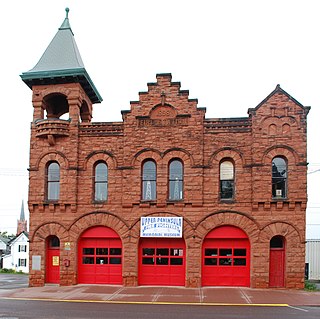
Emergency! is an American action-adventure medical drama television series jointly produced by Mark VII Limited and Universal Television. Debuting on NBC as a midseason replacement on January 15, 1972, replacing two situation comedy series, The Partners and The Good Life, it ran for a total of 122 episodes until May 28, 1977, with six additional two-hour television films during the next two years, 1978 and 1979.

Central Avenue is a major north–south thoroughfare in the central portion of the Los Angeles, California metropolitan area. Located just to the west of the Alameda Corridor, it runs south from the eastern end of the Los Angeles Civic Center down to the east side of California State University, Dominguez Hills and terminating at East Del Amo Boulevard in Carson.

The Los Angeles Fire Department Museum and Memorial is located at Old Engine Co. No. 27, also known as Fire Station No. 27, on Cahuenga Boulevard in Hollywood. The museum houses old fire engines and fire apparatus, some dating from the 1880s. The museum also houses a reference library and fire safety learning center. The building was named a Los Angeles Cultural-Heritage Monument in 1976 and was listed in the National Register of Historic Places in 1985. The Fallen Firefighters Memorial in front of the station consists of a memorial wall listing all of the Los Angeles firefighters who have died in the line of duty and five life-size statues of firefighters.

Austin Central Fire Station 1, is a fire station at 401 East Fifth Street in Downtown Austin, Texas, United States. It is a part of the Austin Fire Department.

The Association of Exempt Firemen Building is located in Hoboken, Hudson County, New Jersey, United States. The building was designed by Francis G. Himpler and was built in 1870. The building was added to the National Register of Historic Places on March 30, 1984 as Assembly of Exempt Firemen Building. The building serves as a firefighters' union hall and as a museum of Hoboken firefighters' memorabilia, the Hoboken Fire Department Museum.

The Calumet Fire Station is a firehouse located on 6th Street in Calumet, Michigan. It is also known as the Red Jacket Fire Station. The building was designated a Michigan State Historic Site in 1971 and listed on the National Register of Historic Places in 1974, and is part of the Calumet Historic District and the Keweenaw National Historical Park. The building now houses the Upper Peninsula Fire Fighters Memorial Museum.

The Prince Hall Masonic Temple in South Los Angeles area of Los Angeles, California is a historic club building associated with Prince Hall Freemasonry. As a contributing building within the 52nd Place Historic District, it was listed on the National Register of Historic Places in 2009.

The Lincoln Theater is a historic theater in South Los Angeles, California. The Moorish Revival building was listed on the National Register of Historic Places in 2009. Sometimes referred to as the "West Coast Apollo", the Lincoln Theater was one of the most significant establishments along the Central Avenue Corridor; this became the cultural and business hub of the African-American community in Los Angeles from the 1920s to the 1950s. For more than 30 years, the Lincoln featured live theater, musical acts, talent shows, vaudeville, and motion pictures, including live performances by the leading African-American performers of the era, including Lionel Hampton, Duke Ellington, the Nat King Cole Trio, and Billie Holiday. The Lincoln Theater was managed and directed by Jules Wolf The theater was converted to use as a church in 1962. It continues to be used for religious services.

Second Baptist Church is a Baptist Church located in South Los Angeles, California. The current Lombardy Romanesque Revival building was built in 1926 and has been listed as a Los Angeles Historic-Cultural Monument (1978) and on the National Register of Historic Places (2009). The church has been an important force in the Civil Rights Movement, hosting national conventions of the National Association for the Advancement of Colored Persons ("NAACP") in 1928, 1942, and 1949, and also serving as the site of important speeches by Martin Luther King Jr., Malcolm X, and others. It is affiliated with the American Baptist Churches USA and the Progressive National Baptist Convention.

The 28th Street YMCA is a historic YMCA building in South Los Angeles, California. It was listed as a Los Angeles Historic-Cultural Monument in 2006 and put on the National Register of Historic Places in 2009. The four-story structure was built in 1926 at a cost of $200,000. The building was designed by noted African American architect Paul R. Williams in the Spanish Colonial Revival style.
Angelus Funeral Home is a funeral home at 1010 E Jefferson Blvd in South Los Angeles, California. It was listed as a Los Angeles Historic-Cultural Monument in 2006 and on the National Register of Historic Places in 2009. In 1925, Angelus Funeral Home was the first Black-owned business to be incorporated in California. The building was designed by noted African-American architect Paul R. Williams in the Spanish Colonial and Georgian Revival styles and also includes Art Deco elements.

The 52nd Place Historic District is a historic district consisting of American Craftsman-style homes in the Central-Alameda neighborhood of South Los Angeles, California. African Americans became the dominant demographic group in the district beginning around 1930, and many leaders of the community resided here. The period of significance is 1930-1958, when a number of African-American neighborhood institutions were founded.

The 27th Street Historic District is a historic district in the South Los Angeles area of Los Angeles, California. The district was listed on the National Register of Historic Places in 2009 as part of the multiple property submission for African Americans in Los Angeles.

Fire Station No. 14 is a historic fire station in the South Los Angeles region of Los Angeles, California. The three-story structure was designed by Earl T. Heitschmidt in the International style and was built in 1949.
The Stentorians are a fraternal organization of African American firefighters, based in Los Angeles, California, and founded in 1954.
Arthur "Smokestack" Hardy was a volunteer fire fighter, photographer, black fire historian and collector of fire memorabilia. He was the first African-American firefighter in Baltimore, Maryland. There is a museum of his collection of fire related artifacts in West Baltimore curated by Guy Cephas, a fellow Retired Auxiliary firefighter. Baltimore has named one of their fire stations after him.

Museo Parque de Bombas is a museum located inside the historic Parque de Bombas in the Ponce Historic Zone in Ponce, Puerto Rico.

Los Angeles Fire Department Station No. 1 was built in 1941. The Streamline Moderne station located at 2230 Pasadena Avenue replaced an older station, 3 blocks west of its current location. Built in 1887, the original station was the city of Los Angeles' first professional, full-time fire station. The former station's plot of land at Pasadena Ave & North Avenue 19 now houses the LAFD's supply and maintenance yard.


















